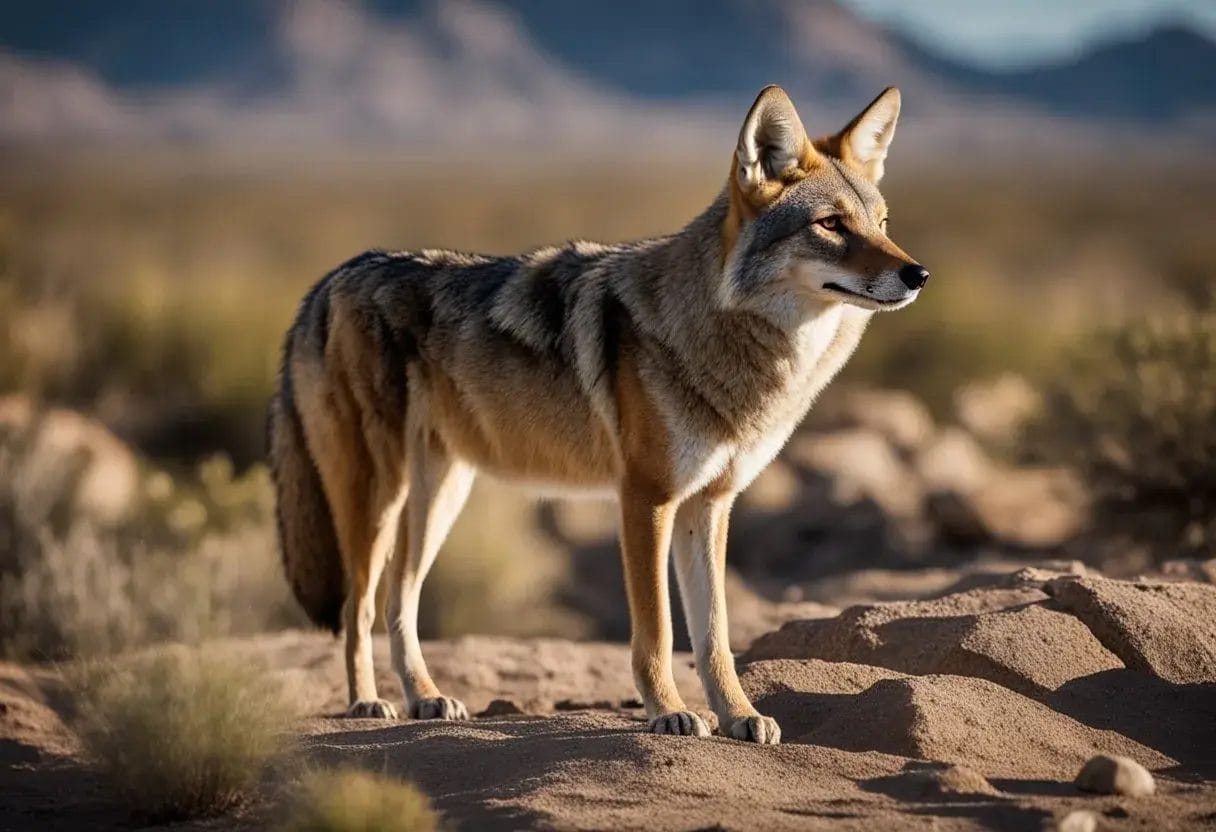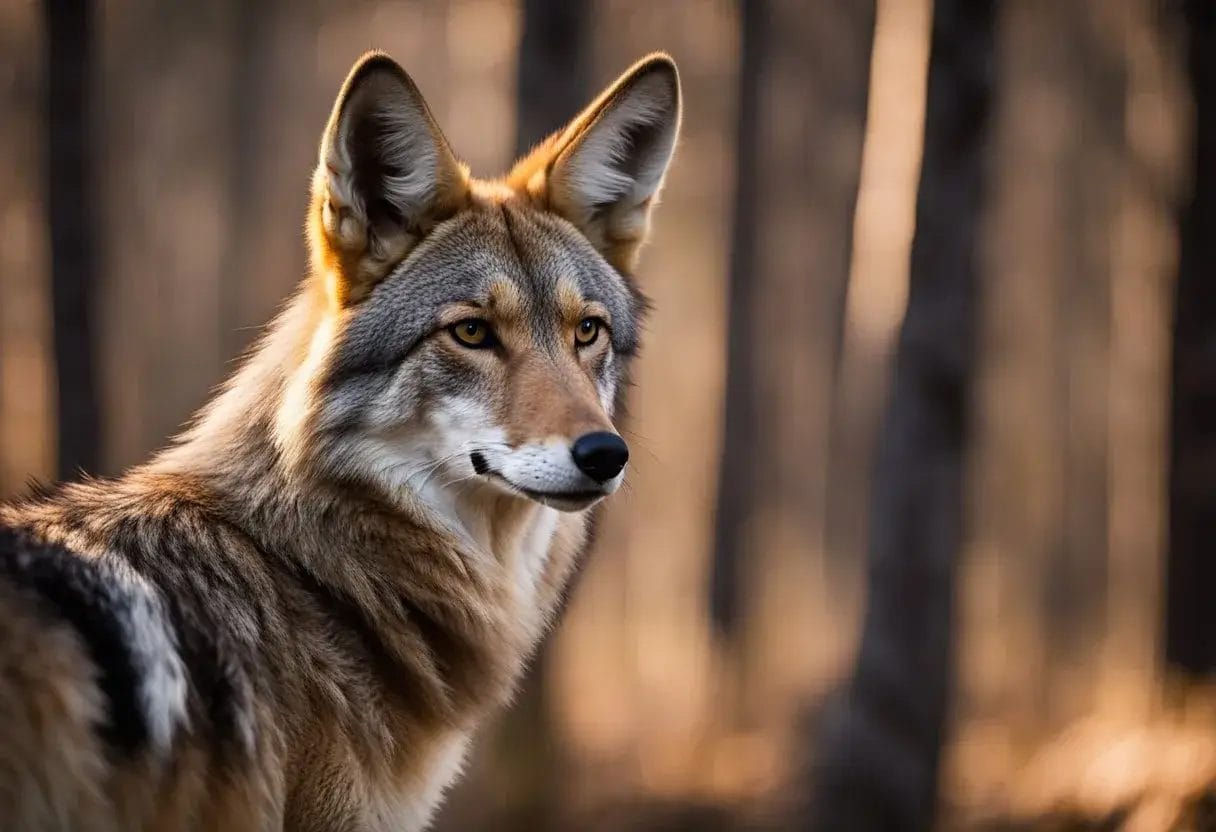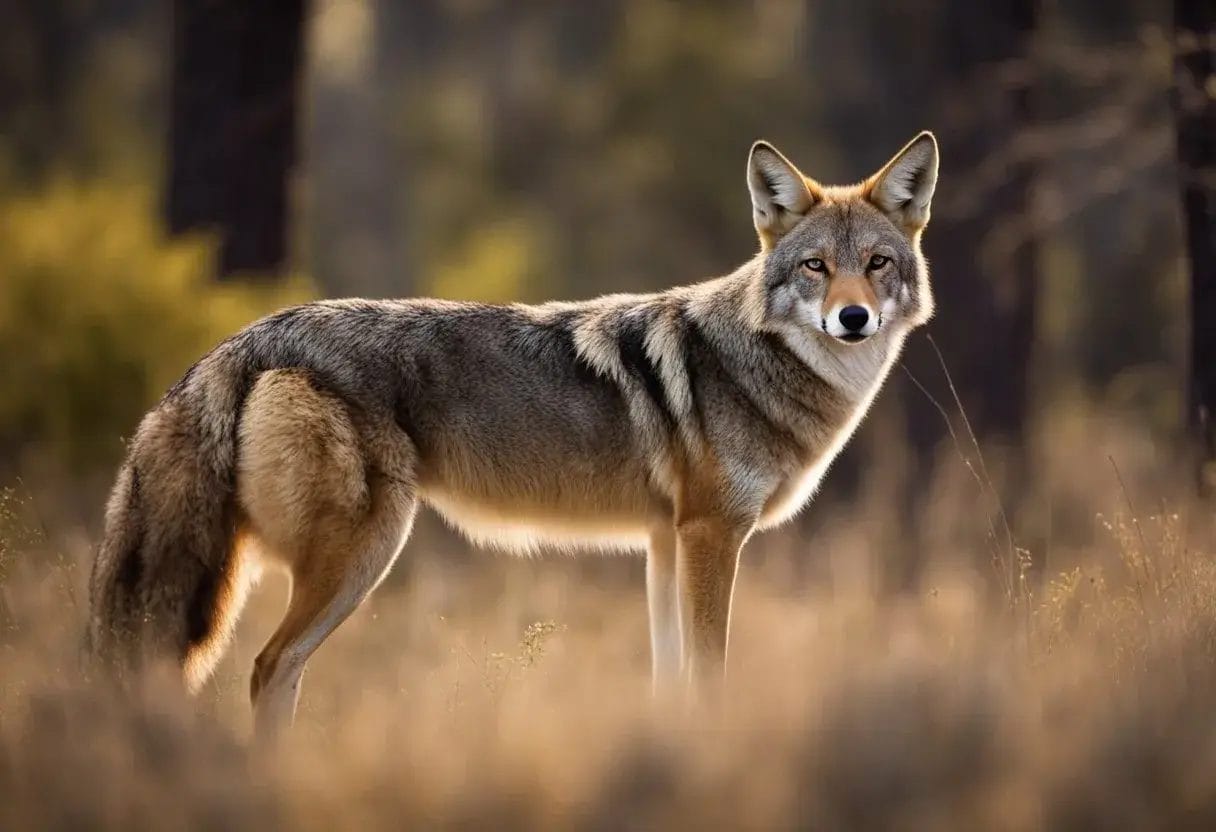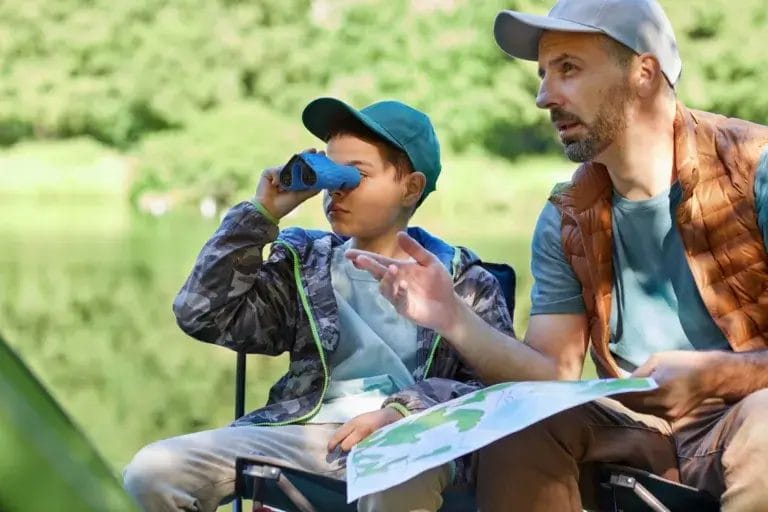What to Do if You See a Coyote While Hiking: Stay Calm, Stay Safe, and Enjoy the Trail
If you love spending time on the trails, you’ll probably cross paths with all sorts of wildlife. Coyotes can be surprising to see, but running into one doesn’t have to be scary if you know what to do.
If you see a coyote while hiking, the best move is to stay calm, stand your ground, make yourself look bigger, and avoid turning your back or running away.

It’s easy to get nervous in the moment, especially if you’re hiking with kids or pets. But you can stay safe and confident on the trail if you learn how coyotes act and what really works to avoid trouble.
Together, we can enjoy the outdoors and keep those wild encounters positive, not stressful.
Key Takeaways
- Know how coyotes behave and respond calmly if you see one.
- Take action to protect your group, especially kids and pets.
- Awareness and preparation help prevent unwanted coyote encounters.
Understanding Coyotes and Their Behavior
When you hit the trails, it’s normal to wonder about the wildlife you might meet. Learning to tell coyotes apart from other animals and knowing their habits helps you stay alert and enjoy your hikes safely.
Identifying Coyotes on the Trail
Let’s talk about what coyotes actually look like. They’re medium-sized, usually weighing between 20 and 50 pounds.
Their fur is grayish-brown, with reddish legs and a long, bushy tail tipped with black. If you spot a wild canid trotting confidently along a path with its tail low, there’s a good chance it’s a coyote.
Coyotes have pointed ears and a narrow, almost fox-like face. You’ll often see them alone or in pairs, moving with a sly, carefree walk that’s pretty distinct.
If you see an animal with a bulky body, rounder ears, or a big, fluffy tail carried high, it’s probably not a coyote. That’s a handy detail to keep in mind.
Key Differences Between Coyotes, Wolves, and Mountain Lions
It’s easy to mix up some of North America’s top predators, so let’s compare them. Coyotes are smaller and skinnier than wolves.
Wolves have big heads, heavily built bodies, and rounded ears. They travel in packs and leave larger paw prints.
Mountain lions, also called cougars, are cats, not canines. They’re much bigger, with a long, thick tail and a smooth, rounded face.
Mountain lions usually avoid people and move in silence. If you see a sleek, tan animal creeping or leaping instead of trotting, that’s probably a mountain lion.
While coyotes sometimes get bold around humans, wolves and mountain lions usually stay far away. Here’s a quick comparison:
| Animal | Ears | Tail | Weight | Moves In |
|---|---|---|---|---|
| Coyote | Pointed | Bushy, black tip | 20–50 lbs | Alone/pairs/small groups |
| Wolf | Rounded | Bushy, low, tip fades | 60–120 lbs | Packs |
| Mountain Lion | Rounded | Very long, solid color | 70–160 lbs | Solo |
Territory and Habits of Coyotes
Coyotes live just about everywhere in North America. You’ll find them in forests, deserts, suburbs, and even city parks.
Their territory can range from a few to several dozen square miles, depending on food. You might see coyotes during the day, but they’re usually more active at dawn and dusk.
They hunt alone or in family units, eating small mammals, fruit, and sometimes leftovers from human trash. Coyotes are smart, curious, and adaptable, so staying alert is important, especially when hiking in areas known for active wildlife presence.
If you want more details about what to do if you see a coyote, check out this coyote safety guide.
How to Stay Safe If You See a Coyote While Hiking
Spotting a coyote on the trail might make you a little nervous. But staying safe is totally doable.
Knowing what to do helps you keep calm and protect yourself. It also makes hikes more enjoyable, even when wildlife pops up close by.
Remain Calm and Assess the Situation
Most coyotes aren’t interested in us. If you see a coyote, just stop walking and try not to panic.
Take a deep breath. It really helps steady your nerves.
Don’t run. Running can make a coyote think you’re prey, which could trigger its instincts.
Instead, keep facing the animal with confidence. Making eye contact (but not glaring) shows you’re aware and alert.
Pick up small children or scoot them behind you if they’re with you. Keeping everyone together makes you look less vulnerable.
Check if the coyote is acting aggressive, shy, or just curious. This helps you respond in the right way without escalating things.
If the coyote is just passing through, sometimes the safest choice is to let it move along. For more tips on staying cool in these moments, check out this guide to coyote safety while hiking.
Make Yourself Look Bigger
Most coyotes will back off if they think you’re a threat. Stand tall, stretch your arms overhead, and wave slowly.
If you’ve got hiking poles, hold them up and wave them. It really makes you look big and hard to mess with.
Making noise works, too. Don’t scream, but use a loud, firm voice to shout or clap.
Banging hiking poles or slapping rocks together adds some backup. The key is to avoid looking scared—confidence is everything.
You might feel a bit silly waving your arms or yelling. But honestly, it’s one of the best ways to tell a coyote, “Hey, I’m not food!”
If you’re carrying a whistle, blow it. For more on making yourself appear stronger, read this advice from an outdoor guide on coyote encounters.
Responding to Different Types of Coyote Behavior
Coyotes act in different ways. Some just watch for a moment and wander off.
Others might come closer to check you out, especially if they’re used to humans. If a coyote gets a little too friendly—like it follows or approaches—raise your hands, shout, and toss small objects nearby (never at its head, just in its direction) to make it want to leave.
If you see a coyote acting bold, like growling or refusing to back away, step up your response. Stay firm, maintain your ground, and repeat those loud noises and big gestures.
Pepper spray or bear spray can help as a last resort if things get scary. Never turn your back or run. That’s what prey animals do.
Back away slowly, keeping eye contact, until you have some distance. On urban trails, sometimes it helps to simply cross the street and let the coyote keep going, as suggested by experienced hikers and local experts.
This way, you respect wildlife while also keeping yourself safe.
Protecting Your Pets and Group Members

When you’re hiking through coyote country, it’s smart to think ahead about keeping everyone safe. Small pets and children need your attention, and a few simple steps can help you stay calm and confident if a coyote shows up on the trail.
Keeping Small Dogs and Pets Close
Keep your small dogs, cats, and other pets on a short leash at all times. Coyotes can be curious and may see unsupervised pets as prey.
If you spot a coyote, quickly and calmly bring your pets close, right at your side or in your arms if possible. Using a standard four to six-foot leash (not a retractable one) gives you better control.
Make extra noise, like shaking a jar of coins or marbles (it’s handy to keep this in your pack), to let coyotes know you’re there. It’s also smart to avoid letting pets wander off-trail or sniff around dense bushes, since coyotes may be hiding nearby.
If your pets start barking or acting anxious, stay calm. Coyotes usually don’t want trouble if they see you’re alert and your pets are right with you.
For more tips about keeping animals close while hiking, check out this safety advice for hiking with coyotes nearby.
What to Do if You’re Hiking with Children
You always want your kids to enjoy nature, but staying safe comes first. If you see a coyote, immediately gather your group together.
Ask kids to stand next to you and hold your hands so you appear bigger and more united as a group. Standing tall and making some noise, like clapping your hands or speaking loudly, can encourage coyotes to leave you alone.
Never run, and remind children not to run either. Quick movements can trigger a chase response.
If little ones are especially young or scared, pick them up or have them ride in a child carrier pack. Giving your little adventurers clear, calm instructions can help them feel less scared.
Reassure them that coyotes are naturally shy and just want to move along, too. For more family-focused ideas, this advice from Advnture’s coyote hiking safety guide is really helpful.
Preventing Coyote Encounters on the Trail

Coyotes are naturally curious, sometimes even bold, but we can definitely cut down our odds of running into one. With a bit of planning, some awareness, and just a few simple habits, we can stay safer while enjoying our hiking adventures.
Choosing the Safest Trails and Times
We all want to wander new paths, but some trails see more wildlife than others. It helps to check for recent coyote sightings or warnings before heading out.
Trailhead signs, park websites, and hiking forums often have updates. Coyotes show up more often at dawn and dusk, so hiking midday can help us avoid them.
Plus, who doesn’t like a little extra sunshine and better views? Sticking to popular hiking routes works well, since coyotes avoid busy spots.
Hiking in a group makes it even less likely we’ll surprise a wild animal. Walking with friends keeps our spirits up and wildlife away, win-win.
Making Your Presence Known
Coyotes usually steer clear of people, but if they don’t realize we’re there, they might get too close. We can make our presence obvious by chatting as we walk, clapping, or even singing.
Carrying a whistle is handy. A couple of sharp blasts tend to scare animals off before we even spot them.
Trekking poles or hiking sticks can be tapped together for extra noise. Wearing bright clothes helps too—standing out in nature lets animals see and avoid us.
If singing out loud feels awkward, just remember it’s less embarrassing than a surprise coyote encounter!
Handling Food and Trash While Hiking
Food is a magnet for coyotes. Their noses are incredible, so leftover snacks or an open lunch can bring them way too close.
Packing food in sealed, scent-proof bags is smart. Even on short hikes, resealable containers beat loose packaging every time.
After eating, it’s worth checking for crumbs or dropped food. All trash, even fruit peels, should go straight into a sturdy, sealable bag.
If we’re camping, keep food and trash far from the tent, hanging it from a tree if you can. These habits keep coyotes and other critters away, so everyone stays safer. For more practical tips, check out this guide on handling food and trash while hiking.
Health Risks and What to Watch Out For

Seeing a coyote on the trail isn’t just about the animal. There are health risks, too, diseases they might carry, plus ticks or parasites that could hitch a ride.
Rabies, Parvo, and Other Diseases
Coyotes can carry some nasty stuff. Rabies is the big one, rare, but almost always deadly if untreated.
If a coyote acts confused, aggressive, drools, or just seems off, that’s a red flag. We should keep our distance and get help if we see weird behavior.
Parvovirus (parvo) is another concern, especially for dogs. Coyotes can spread it, and the virus hangs around in soil for months.
If we hike with dogs, making sure they’re vaccinated is key. Coyotes may also spread distemper and mange, which can affect animals too.
Watching our four-legged hiking buddies and steering clear of sick wildlife is just common sense. For more on coyote safety, here’s a helpful guide.
Ticks and Parasite Concerns
Coyotes often have ticks and fleas. When we’re in their territory, those bugs might find us or our pets, too.
Ticks can carry Lyme disease and other illnesses. Staying on wide trails and wearing long socks or pants makes bites less likely.
It’s smart to do a quick tick check after every hike, especially if we’ve gone through tall grass. Run your hands through your hair and check behind your knees or underarms, those spots get missed a lot.
Don’t forget to check pets as well. Fleas from coyotes can carry tapeworms, which sometimes infect dogs or, rarely, people.
Keeping dogs leashed and away from coyote dens is an easy way to lower risks. Monthly flea and tick prevention helps everyone focus on enjoying the hike instead of worrying.
What to Do After a Coyote Encounter
If we spot a coyote while hiking, staying safe comes first. Once everyone’s okay, it’s worth sharing our experience so others can learn and stay safe, too.
Reporting Sightings to the Right Authorities
If a coyote acts boldly, follows people, or hangs out near the trail, it’s helpful to alert the right folks. We can call the local park office, animal control, or a ranger.
Some places even suggest calling 911 if the coyote seems aggressive. Sharing what happened lets wildlife managers track patterns and keep trails safer.
It’s good to note the date, time, and exact spot. If the coyote did anything odd, like approach hikers or pets, describe it clearly.
Many parks and city websites have easy online forms for reporting coyote sightings. Some hikers suggest reporting to Animal Control, just like in this Quora post.
There’s no need to exaggerate, just be honest and calm. Even small details can help experts spot trends and keep everyone safer out there.
Consulting a Wildlife Biologist or Specialist
After a strange coyote encounter, reaching out to a wildlife biologist or local expert can clear up any lingering questions. These folks know coyote habits in our area and can say if what we saw is normal or something to watch.
We might find wildlife biologists through state agencies, universities, or local nature groups. Many enjoy talking to hikers and often share helpful tips about coyote safety, like using bear spray in some regions, as discussed in this Reddit thread.
Asking questions helps us feel more confident next time we hit the trail. Staying curious and connected to experts means we’re looking out for both people and the wild animals we share space with.
Coyote Myths and Facts

Coyotes spark strong opinions, but there’s a lot of misinformation floating around. As we spend more time outdoors, it really helps to sort fact from fiction and get to know our wild neighbors a bit better.
Common Misconceptions About Coyotes
We’ve all heard tales about coyotes being fierce predators always hunting in packs. The truth? Most coyotes hunt and travel alone or in pairs, only teaming up for mating or raising pups.
That busts the myth that every coyote has a hidden pack waiting in the bushes. It’s also easy to think coyotes are aggressive toward people, but in reality, they usually avoid us and attacks are extremely rare.
If we spot one, it’s almost always more curious or cautious than threatening. Making ourselves look bigger and making a bit of noise usually sends them running. Here’s more on how to avoid conflicts with coyotes.
Coyotes do go after small pets if they get a chance, but mostly they hunt rodents, rabbits, and sometimes fruit. The idea that they’re a huge threat to all wildlife just isn’t accurate.
Quick Facts Table
| Myth | Reality |
|---|---|
| Always in packs | Often alone or in pairs |
| Very aggressive | Usually shy and cautious |
| Eats pets mostly | Rodents and rabbits are favored |
The Role of Coyotes in North American Ecosystems
Coyotes aren’t just scavengers looking for scraps near campsites. They actually play a big part in keeping North American ecosystems balanced.
By hunting rodents and rabbits, they help control populations of smaller animals, which can prevent disease and crop damage. They’re also scavengers, cleaning up dead animals and keeping the environment healthier for everyone.
People sometimes overlook how adaptable coyotes are. They live everywhere from quiet forests to city edges, adjusting their habits to whatever food’s around.
When coyotes are part of the landscape, we usually see fewer pests and more wildlife variety. That keeps our hikes peaceful and nature-filled. For more on how coyotes shape wild spaces, check out this article.
Frequently Asked Questions
Running into a coyote on the trail brings up a lot of questions. We all want to enjoy the outdoors, feel safe, and make sure our friends and pets stay protected.
What steps should I take if a coyote approaches me while I’m hiking?
First, don’t run. Let’s stand our ground.
Most coyotes are curious, not dangerous. If one comes closer, make eye contact, raise your arms, and speak firmly or even shout.
Wave your arms, clap, or use hiking poles to look bigger. If it keeps coming, that’s when you might want to get louder.
Try tossing small sticks or rocks near it, not at it, to make your point. There’s a helpful coyote safety guide with more ideas if you’re curious.
How can I safely observe a coyote if I see one during my daytime hike?
Spot a coyote in the distance? Stay calm and enjoy the view, but don’t get closer.
Definitely don’t try to feed it. Just keep moving along the trail and give it space.
Binoculars are perfect for a closer look without any risk. They’re honestly a must-have for wildlife fans.
What precautions should I take when hiking with my dog in coyote territory?
Keep your dog on a short leash, always. Coyotes see loose dogs, especially small ones, as either a threat or an easy target.
Don’t let your dog wander off-leash, and keep an eye out for movement ahead. It’s just not worth the risk.
A walking stick or a noisemaker can help you feel more ready. If you want more tips, check out ways to avoid coyote conflicts.
If I’m hiking and a coyote seems aggressive, how should I respond?
If a coyote follows you, growls, or gets too close, stay calm but act confident. Face the coyote, back away slowly, and make yourself look and sound as big as you can.
Never turn your back or run. Sometimes, tossing an object toward the coyote scares it off.
Is there a safe way to walk at night in areas known for coyotes?
Night hikes are a bit riskier, since coyotes get more active after dark. If you go, stick to well-lit, busy paths and bring a flashlight.
Don’t walk alone. Stay alert, keep pets close, and make some noise so coyotes know you’re around.
Can you share any tips for preventing a coyote encounter while on the trail?
If you make regular noise while hiking, whether you’re chatting, singing, or just clapping, coyotes usually pick up on it and steer clear. I’d say it’s smart to stick to the main trails and try to hike with others when you can; solo hikes just seem a bit riskier.
Don’t leave snacks or trash behind, since even a crumb can attract a curious coyote. Some folks like to carry bear spray in certain areas, just for peace of mind.








